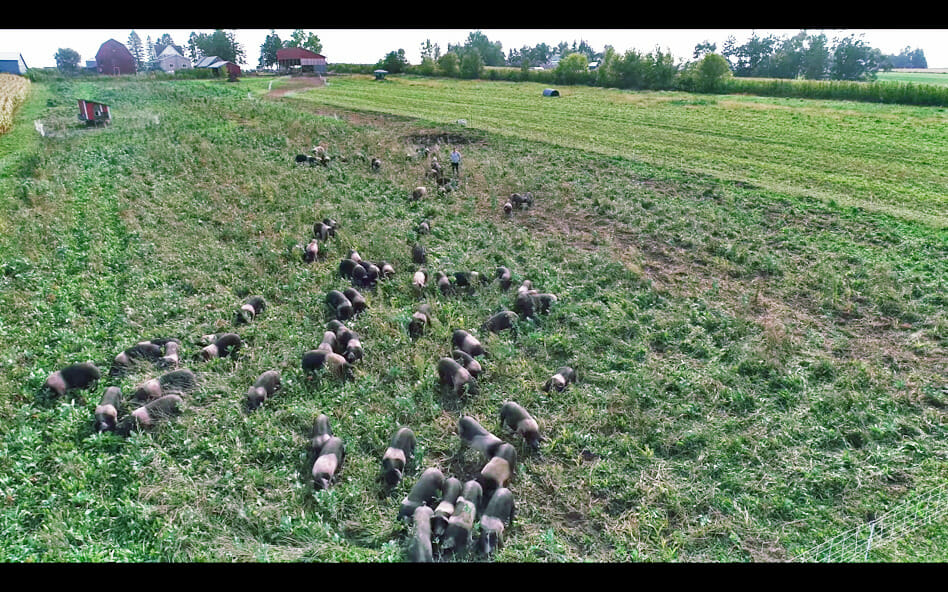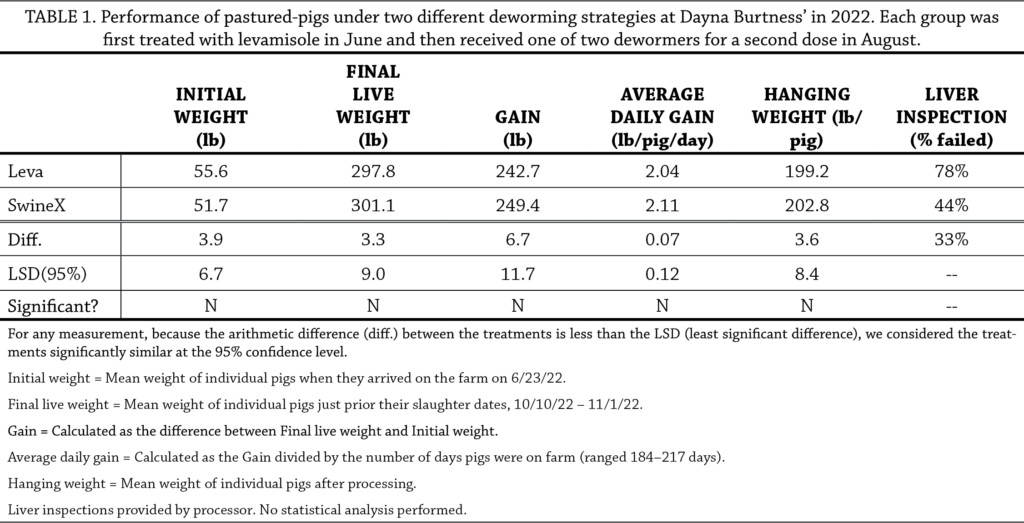This research was funded by McKnight Foundation.
In a Nutshell:
- Dayna Burtness raises pigs on pasture in southeast Minnesota and has a goal of reducing her farm’s reliance on chemical dewormers due to their perceived negative soil health effects.
- In this experiment, she asked: When administered as the second intervention in a two-intervention (1-late June, 2-late August) deworming program, how does an alternative dewormer (i.e., SwineX) affect average daily gain, final live weight, hanging weight and percentage of livers passing inspection of pasture-raised pigs compared with levamisole (chemical dewormer)?
Key Findings
- There were no statistically significant differences between the control group and the SwineX test group. Final average daily gains, pass/fail scores of livers, live weights and hanging weights of pigs administered levamisole-SwineX were statistically similar to pigs administered levamisole-levamisole.
Background
Pastured pigs are naturally exposed to parasites when they ingest long-lasting eggs that can lay dormant in the soil for years or eat parasite host species such as earthworms. While these parasites do not affect the humans eating the pork, parasites can cause health problems in pigs and poor feed conversion ratios by competing with the pig for nutrients. Trichinella spiralis is an exception — eating undercooked pork from an infected pig can cause trichinosis in humans. However, this parasite has been largely controlled in the United States and now most cases of trichinosis are caused by eating wild game.[1]
Since the feed ration is often the largest cost associated with pasture finished hogs, many farmers will use antihelmenthics or “dewormers” to reduce populations of internal parasites in their pigs and improve the feed to weight gain ratio.
The objective of this project was to compare the average daily gains (ADGs) final live and hanging weights, and the pass/fail scores of livers of two groups of pastured-pigs: one group treated with levamisole (LevaMed) in June and again in August and a second group treated with levamisole in June and SwineX (alternative dewormer) in August. Burtness hypothesized that deworming with LevaMed twice would result in better ADGs. Mostly, she was looking forward to finally getting some answers to a hotly debated and important question: How do natural dewormers (e.g., SwineX) affect ADGs compared to chemical dewormer?

Pigs in one of the pasture paddocks at Dayna Burtness’ in 2022. Drone photography courtesy of Kiley Friedrich from Monarch Joint Partners.
Methods
Design
The pigs arrived at Burtness’ farm in southeast Minnesota on June 23 and all were subsequently treated with the dewormer levamisole injected into their water supply via a Dosatron. Dose was determined after the pigs were weighed using a WayPig505 scale upon arrival. Pigs were then reared on diverse annual and perennial pastures while also having unlimited access to water and hog feed (certified organic pea and barley ration). On August 5, two separate treatment groups of pigs were created with each consisting of 10 pigs:
- Leva: Pigs received LevaMed as the second deworming intervention after first receiving LevaMed upon arrival to the farm. LevaMed was injected into their drinking water through a Dosatron at the rate on the label. Pigs were kept off pasture and confined to the central deep bedded barn until they had finished the treated water (24 hours).
- SwineX: Pigs received SwineX as the second deworming intervention after first receiving LevaMed upon arrival to the farm. Pigs were kept off pasture and confined to an isolation pen wherein SwineX was mixed into their feed at the rate on the label until they finished the treated feed (24 hours). The water in the isolation pen was untreated. SwineX consists of diatomaceous earth, neem bark, ginger root and garlic.
Apart from the treatments the pigs were managed similarly; they were raised on pasture and received equal access to feed and water. By the end of the experiment, each group had one pig disqualified from the trial (one lost an ear tag at the same time as other similar sized and colored pigs and couldn’t be reliably identified, one received special treatment for an ear infection) resulting in nine pigs in each group. Slaughter dates ranged from Oct. 10 to Nov. 1.
Measurements
Pigs were weighed every two to three weeks from the time they arrived on the farm to just before they were slaughtered. Hanging weight and pass/fail liver inspections were provided by the processor.
Burtness collected two rounds of fecal samples and sent them away to Dr. Alexander Hernandez’s lab at Kutztown University of Pennsylvania for detection of parasite eggs. In the first round of samples taken in late June, low levels of Ascaris suum (Roundworm) and eggs of an unidentified Trichostrongylus nematode were found in some fecal samples from each trial group but not all.
In the second round of fecal samples taken in early August, a large roundworm was found in one composite sample from the Leva group but no roundworm eggs were found in any samples. Trichuris suis (whipworm) eggs were found at low eggs per gram (EPG) in some samples from each group but not all. Because the first two rounds of fecal samples were not showing large numbers of EPGs, a third round was not collected due to the expense of labor and shipping.
Data analysis
To evaluate the effect of de-wormer on pigs, we calculated the least significant difference (LSD) at the 95% confidence level using a t-test. If the difference between the two treatments was greater than the LSD, we would expect such a difference to occur 95 times out of 100 under the same conditions – we referred to this as a statistically significant effect. On the other hand, if the resulting difference between the two treatments was less than the LSD, we considered the results to be statistically similar. We could make these statistical calculations because Burtness’ experimental design involved nine replicates of the two treatments.
Results and Discussion
Final live weight, gain, average daily gain and hanging weight were statistically similar between treatment groups (Table 1). In other words, the pigs treated with SwineX in August performed equally well as the pigs treated with levamisole in August.
A crucial piece of this trial was collecting the pass/fail data on the livers. In light of the low EPGs from the fecal samples, it would have been possible to suggest that the lack of statistically significant differences between the groups was due to a lack of parasites. However, the prevalence of liver “milk spots” which led to a USDA inspector designation of “fail” was proof that roundworms were present (Table 1). “Milk spots” are small, temporary lesions that the Ascaris suum parasite leaves on hog livers during their life cycle.[2] And according to Dr. Hernandez at Kutztown University of Pennsylvania, “It is possible to have a heavy worm-load but a completely clean fecal due to the ‘prepatent period’ of parasites or intermittent laying of eggs by mature parasites. The prepatent period is the time after ingestion of a parasite’s infective stage that it takes for that parasite to mature and begin producing eggs excreted in feces. Furthermore, it’s also a well-established ‘rule’ in parasitology that there will be a lot of variability between individuals in a population as far as the degree of infection, with most individuals showing light infections or no infection at all, while only a few individuals are heavily infected. The causes of this are active areas of research in disease biology, with suggested causes being variability in age, genetics, gender, or behavior of hosts, among other variables.”
“I honestly didn’t think the SwineX would work,” Burtness said when starting the trial. After seeing the results – no difference from using levamisole twice – she is starting to become convinced that SwineX may in fact be a viable option for deworming on her farm.
Conclusions and Next Steps
“I’m on my way to being convinced that I don’t need to use chemical dewormers like levamisole but another year of trialing is necessary,” Burtness said after reviewing the results. Next year she intends to repeat the trial but with a third treatment group: one that receives no dewormer at the time of second intervention in August. Depending on the results of the 2023 trial, in 2024 she plans to expand the trial to include a group that receives no dewormers throughout the entire finishing season.
Acknowledgements
Dayna Burtness is grateful to those who helped her complete this on-farm research project.
- Alex Hernandez, Parasitologist and Associate Professor of Biology at Kutztown University of Pennsylvania.
- Tom Roskos, DVM
- The Nettle Valley Farm data collection crew: Heidi Eger, Maddi MacDonald, Alyse Festenstein, Matt Crisp, Nick Nguyen
References
- Department of Veterinary Diagnostic & Production Animal Medicine. Trichinellosis. https://vetmed.iastate.edu/vdpam/FSVD/swine/index-diseases/trichinellosis (accessed January 2023).
- National Animal Disease Information Service. Ascariasis. NADIS Animal Health Skills. https://www.nadis.org.uk/disease-a-z/pigs/ascariasis/ (accessed January 2023).



